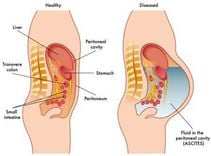This is an automatically translated article.
The article was professionally consulted by MSc Vu Van Quan - Department of General Surgery & Anesthesia - Vinmec Hai Phong International General Hospital.
Acute liver failure is a rare serious disease that can be life-threatening if not detected and treated promptly. The following article helps you better understand this disease.
1. What is acute liver failure?
Acute liver failure is a complex medical condition that occurs after a harmful effect on the liver. The characteristic presentation of liver failure is jaundice, coagulopathy, and short-term progressive hepatic encephalopathy in a patient with previously normal liver function.
2. Causes of acute liver failure
2.1. Microbial causes Due to hepatitis A, B, C, E viruses, hepatitis B virus is the most common cause in Vietnam. Other viruses: Cytomegalovirus, Herpes, Epstein Barr, chickenpox. Bacteria: found in patients with severe infections and septic shock, the rate of liver damage and acute liver failure is 20-5%. Parasites: malaria, liver flukes, worms. 2.2. Due to poisoning 2.2.1. The most common drug is Paracetamol even at the usual therapeutic doses in alcoholic patients, or used in conjunction with drugs metabolized by the enzyme Cytochrome 450 such as anticonvulsants. Other drugs: Isoniazid, Rifampicin, Non-Steroid Anti-Inflammatory Drugs, Sulphonamides, Phenytoin, Tetracycline, Allopurinol, Ketoconazole, MAO... Poisoning with traditional medicines, especially preservatives. 2.2.2. Types of molds A typical example is Amianita phalloides.
2.2.3. Other causes Acute fatty liver syndrome in pregnant women. Large vessel occlusion in the liver. Reys syndrome.
3. Symptoms of acute liver failure
Common clinical symptoms in patients with acute liver failure include:
Characteristic symptoms: jaundice, fatigue, nausea. Lucke and Mallory's division: Divided into 3 stages: Prodromal is the stage without jaundice. Intermediate stage is marked by the appearance of jaundice. The final stage is with manifestations of hepatic encephalopathy. Classic clinical classification: based on the distance from the manifestation of jaundice to the appearance of encephalopathy. Fulminant liver failure: 7 days Acute liver failure: 8 to 28 days Subacute liver failure: 5 to 12 weeks. Hepatic encephalopathy: plays a central role in the diagnosis of acute liver failure divided into 4 grades: Grade I: altered affective status, impaired concentration and reduced psychomotor function, excitable . Grade II: slowness, inappropriate behavior, still able to speak. Grade III: lethargy, disorientation, agitation. Grade IV: coma, possibly responsive to painful stimuli. The patient may be assigned some of the following tests, but none of them is specific.
To limit the progression of liver failure, patients need to regularly check their health periodically, and at the same time need to follow the doctor's instructions to achieve the best treatment effect.














